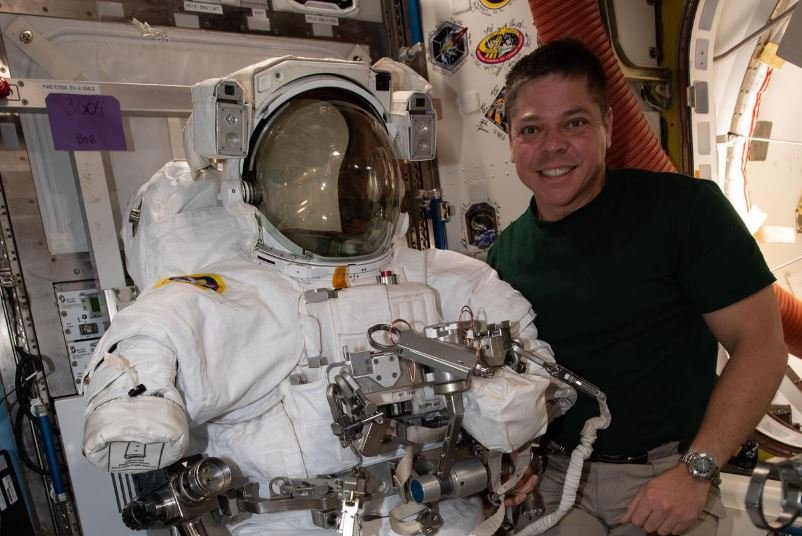
July 16 (UPI) — NASA’s latest spacewalk at the International Space Station concluded on Thursday with two astronauts replacing more aging batteries.
Bob Behnken and Chris Cassidy spent six hours in space during the 230th spacewalk at the orbiting laboratory.
The astronauts replaced six nickel-hydrogen batteries with three new lithium-ion batteries, with NASA nearing completion of a two-year project to upgrade the space station’s power system.
Astronauts have removed 48 aging power cells, and 23 of the newer 400-pound batteries were installed — during 11 spacewalks. One final new battery awaits installation.
The next spacewalk will be the 300th involving U.S. astronauts since Ed White stepped out of his Gemini 4 capsule on June 3, 1965.
On Tuesday, the astronauts plan to perform other maintenance — including preparations for the arrival of a new airlock built by Houston-based NanoRacks, designed to release experiments into space. SpaceX plans to send the new airlock later this year.
Astronaut Doug Hurley joined the duo Wednesday afternoon for a spacewalk review and a conference with specialists on the ground, according to NASA. He assisted astronauts in and out of their spacesuits and monitored spacewalk activities.
Hurley also did a brief medical exam of his crewmates “similar to a doctor conducting a checkup on Earth,” NASA said.
Behnken and Hurley arrived at the space station May 31 as part of the historic return to crewed spaceflight from U.S. soil. The mission also marked the first time Elon Musk‘s SpaceX carried humans into space.
NASA extended the historic trip to space — planned initially as a five-day demonstration — by several months because the batteries needed replacement.
Those replacements will “put the station in a much better configuration long-term,” Kenneth Todd, the space station’s manager for integration and operations, told reporters last month.
Astronauts return to space from U.S. soil

NASA astronauts Doug Hurley (L) and Bob Behnken, who flew the Crew Dragon spacecraft to the International Space Station, brief mission controllers about their experience in the new vehicle on June 1. Photo courtesy of NASA

Newly arrived NASA astronauts Bob Behnken and Doug Hurley, front row from left to right, pose for a photo with the rest of the crew aboard the International Space Station on May 31. On the back row, from left to right are Roscosmos flight engineer Anatoly Ivanishin, NASA Commander Chris Cassidy and Roscosmos engineer Ivan Vagner. Photo courtesy of NASA

SpaceX’s Dragonship Endeavor, with Behnken and Hurley on board, docks with the International Space Station at 10:16 am EST on May 31. The Crew Dragon’s nose cone is open, revealing the spacecraft’s docking mechanism that would connect to the Harmony module’s forward international docking adapter. Photo courtesy of NASA | License Photo

The SpaceX Falcon 9 rocket lifts off at 3:22 p.m. May 30 with Hurley and Behnken aboard the first manned Crew Dragon spacecraft from Complex 39A at Kennedy Space Center in Florida on May 30. Photo by Bill Ingalls/NASA | License Photo

The Demo-2 mission is the first launch with astronauts of the SpaceX Crew Dragon spacecraft and Falcon 9 rocket to the ISS as part of the NASA’s Commercial Crew Program. Photo by Joel Kowsky/NASA | License Photo

Spectators on Cocoa Beach, Fla., watch as Behnken and Hurley lift off from Kennedy Space Center’s Pad 39-A onboard SpaceX Demo-2 Falcon 9 and the Crew Dragon to the ISS. Photo By Gary I Rothstein/UPI | License Photo

Hurley (L) and Behnken depart the Neil A. Armstrong Operations and Checkout Building at Kennedy Space Center. Photo by Joe Marino/UPI | License Photo

Behnken gives a thumbs-up. Photo by Joe Marino/UPI | License Photo

A SpaceX Crew Dragon spacecraft and Falcon 9 rocket stand on Launch Complex 39A on May 29. Photo by Joe Marino/UPI | License Photo

NASA and SpaceX were attempting the launch a second time after the launch was scrubbed on May 27 due to weather. Photo by Joe Marino/UPI | License Photo

Hurley (L) and Behnken depart the checkout building. Photo by Joe Marino/UPI | License Photo

The Falcon 9 vents fuel after NASA and SpaceX management called a hold to the launch on May 27 due to weather. Photo by Joe Marino/UPI | License Photo

Hans Koenigsmann, vice president for build and flight reliability at SpaceX, looks at a monitor showing a live feed of the rocket carrying the company’s Crew Dragon spacecraft on the pad during the countdown on May 27. The launch was scrubbed with only minutes to go. Photo by Joel Kowsky/NASA | License Photo

Spectators leave Cocoa Beach after the launch was canceled. Photo By Gary I Rothstein/UPI | License Photo

Behnken (L) and Hurley are seen in the crew access arm at Launch Complex 39A on May 27. They were strapped into the Crew Dragon capsule when weather forced a postponement. Photo courtesy of SpaceX | License Photo

From left to right, Kennedy Space Center Director Bob Cabana, second lady Karen Pence, Vice President Mike Pence, first lady Melania Trump, President Donald Trump, Marillyn Hewson, CEO of Lockheed Martin, Mike Hawes, vice president of human space exploration and Orion program manager at Lockheed Martin Space, and NASA Administrator Jim Bridenstine stop by the Artemis I capsule during a tour of the Armstrong operations building. Photo by Bill Ingalls/NASA | License Photo

Trump participates in a SpaceX Demonstration Mission 2 launch briefing following the departure of NASA astronauts to board a SpaceX Crew Dragon spacecraft on May 27. Photo by Bill Ingalls/NASA | License Photo

Hurley (L) and Behnken, wearing SpaceX spacesuits, prepare to depart the operations building for Launch Complex 39A to board the SpaceX Crew Dragon spacecraft. Photo by Bill Ingalls/NASA | License Photo

From left to right, SpaceX owner and chief engineer Elon Musk, Bridenstine, Mike Pence and Karen Pence applaud the astronauts as they head to the spacecraft. Photo by Bill Ingalls/NASA | License Photo

Hurley (L) and Behnken give their families virtual hugs as they prepare for the Demo-2 mission launch. Photo by Bill Ingalls/NASA | License Photo

Hurley boards a Tesla Model X for the ride to the launch area. Photo by Joe Marino/UPI | License Photo

A SpaceX Crew Dragon spacecraft and Falcon 9 rocket lie horizontally on Complex 39A on May 26. Photo by Joe Marino/UPI | License Photo

The Vehicle Assembly Building is seen at sunset as preparations continue for the NASA’s SpaceX Demo-2 mission on May 25. Photo by Joel Kowsky/NASA | License Photo

In this black-and-white infrared image, a SpaceX Falcon 9 rocket with the company’s Crew Dragon spacecraft onboard is seen on the launch pad. Photo by Joel Kowsky/NASA | License Photo

This is a view of the crew access arm in position with the Crew Dragon spacecraft and the SpaceX Falcon 9 rocket on May 24. Photo courtesy of SpaceX | License Photo

Behnken and Hurley are seen on a monitor showing inside the Crew Dragon capsule at Launch Complex 39A during a dress rehearsal May 23. Photo by SpaceX/UPI | License Photo

Hurley (L) and Behnken participate in a dress rehearsal for launch at Kennedy Space Center on May 23. Photo by Kim Shiflett/NASA | License Photo

Behnken rehearses putting on his SpaceX spacesuit in the astronaut crew quarters. Photo by Kim Shiflett/NASA | License Photo

Hurley and Behnken return to the Armstrong building from Launch Complex 39A after completing the dress rehearsal. Photo by Bill Ingalls/NASA | License Photo

Norm Knight, deputy director of Flight Operations at NASA’s Johnson Space Center (L), and Steve Stich, deputy manager of NASA’s Commercial Crew Program (R), monitor the countdown during the dress rehearsal. Photo by Joel Kowsky/NASA | License Photo

Hurley (L) and Behnken depart the Armstrong building for Launch Complex 39A. NASA Photo by Bill Ingalls/UPI | License Photo

NASA and SpaceX managers participate in a flight readiness review for the upcoming Demo-2 launch in the Operations Support Building II at Kennedy Space Center on May 21. Photo by Kim Shiflett/NASA | License Photo

A SpaceX Falcon 9 rocket with the Crew Dragon spacecraft onboard is seen as it is rolled out of the horizontal integration facility at Kennedy Space Center as preparations continue on May 21 for the Demo-2 mission. Photo by Bill Ingalls/NASA | License Photo

The rocket is raised into a vertical position on the launch pad as preparations continue for the mission. Photo by Bill Ingalls/NASA | License Photo

From left to right, Behnken and Hurley pose with Bridenstine and Cabana after the astronauts’ arrival at the space center in Florida on May 20. Photo by Joe Marino/UPI | License Photo

The two astronauts arrive to be the first crew to launch from the Kennedy Space Center on the SpaceX Crew Demo spacecraft. Photo by Joe Marino/UPI | License Photo

Hurley speaks to the media following his arrival at the Kennedy Space Center. Photo by Joe Marino/UPI | License Photo

The SpaceX Crew Dragon spacecraft arrives at Launch Complex 39A at NASA’s Kennedy Space Center in Florida, transported from the company’s processing facility at Cape Canaveral Air Force Station on May 15. Photo by Kim Shiflett/NASA | License Photo

The SpaceX Crew Dragon spacecraft that will be used for the Crew-1 mission for NASA’s Commercial Crew Program undergoes processing inside the clean room at SpaceX headquarters in Hawthorne, Calif. Photo courtesy of SpaceX | License Photo

Behnken (L) and Hurley successfully completed a fully integrated test of Crew Dragon’s critical flight hardware at a SpaceX processing facility on Cape Canaveral Air Force Station in Florida on March 30. Photo courtesy of SpaceX | License Photo

NASA and SpaceX completed an end-to-end demonstration of the teams’ ability to safely evacuate crew members from the fixed service structure during an emergency situation at Launch Complex 39A on April 3. Photo courtesy of SpaceX | License Photo

The SpaceX Crew Dragon spacecraft undergoes final processing at Cape Canaveral Air Force Station in Florida. Photo courtesy of SpaceX | License Photo

Hurley examines the critical flight hardware during the test on March 30. Photo courtesy of SpaceX | License Photo

Hurley (R) and Behnken participate in SpaceX’s flight simulator. Photo courtesy of SpaceX | License Photo

SpaceX teams executed a full simulation of launch and docking of the Crew Dragon spacecraft, with Hurley (R) and Behnken participating in SpaceX’s flight simulator on March 19 and 20. Photo courtesy of SpaceX | License Photo

SpaceX’s Crew Dragon capsule completes acoustic testing in Florida. Photo courtesy of SpaceX | License Photo

Hurley (L) and Behnken stand near Launch Pad 39A during a dress rehearsal ahead of the SpaceX uncrewed In-Flight Abort Test at Kennedy Space Center on January 17. In the background, the company’s Falcon 9 rocket is topped by the Crew Dragon spacecraft. The flight test will demonstrate the spacecraft’s escape capabilities. Photo by Kim Shiflett/NASA | License Photo

Bridenstine (L) and Musk converse at Kennedy Space Center’s launch control center while awaiting liftoff of a SpaceX Falcon 9 rocket and Crew Dragon spacecraft on the uncrewed in-flight abort test on January 19. Photo by Kim Shiflett/NASA | License Photo

Hurley (R) and Behnken don SpaceX spacesuits in the astronaut crew quarters during a dress rehearsal. Photo by Kim Shiflett/NASA | License Photo

The test, which did not have NASA astronauts aboard, demonstrated Crew Dragon’s ability to reliably carry crew to safety in the unlikely event of an emergency on ascent. Photo courtesy of SpaceX | License Photo

A SpaceX Falcon 9 rocket boosts the Crew Dragon spacecraft for NASA on a launch abort test from Complex 39A at Kennedy on January 19. SpaceX conducted the test as a final measure to assure safety for future crewed missions to the ISS. Photo by Joe Marino-Bill Cantrell/UPI | License Photo


